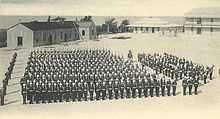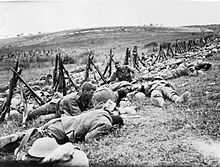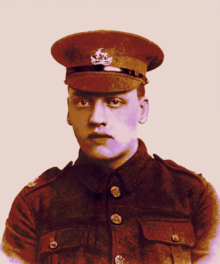Royal Warwickshire Regiment
| The Royal Warwickshire Fusiliers | |
|---|---|
| Active | 1685–1968 |
| Country |
|
| Branch |
|
| Type | Infantry |
| Role | Line infantry |
| Size |
1-4 Regular Battalions |
| Garrison/HQ | Budbrooke Barracks, Warwickshire |
| March |
Quick: The British Grenadiers, Warwickshire Lads |
| Mascot | Indian black buck antelope, 'Bobby'[1] |
The Royal Warwickshire Fusiliers, previously titled the 6th Regiment of Foot and The Royal Warwickshire Regiment, was an infantry regiment of the British Army. After service in many conflicts and wars, including the First and Second World Wars, it was absorbed in 1968, along with the Royal Northumberland Fusiliers, the Royal Fusiliers and the Lancashire Fusiliers, into the newly created Royal Regiment of Fusiliers.
History
The regiment traces its origins to the 17th century. In Holland in 1674 the government retained two regiments of English troops, two of Scots and one Irish. In 1685 when James II requested their services during the Duke of Monmouth's rebellion and organised them into two units, given the precedence as the 5th and 6th Regiments of Foot.
After Monmouth's defeat they returned to Holland, but when William III became king of England in 1688 they accompanied him, with their seniority being confirmed from 1685. The 6th were nicknamed "The Dutch Guards" by William. Service in Ireland followed and the regiment was present at the Battle of the Boyne in 1690 and Aughrim in 1691. Campaigning in Flanders 1692-1695 followed, with action at Steenkirk 1693 and the storming of Namur 1695 which was the 6th's first battle honour.
The 18th century
During the War of the Spanish Succession the 6th were in Spain and Portugal fighting the armies of Spain and France. The regiment fought at Barcelona in 1706 and suffered heavy casualties at Almanza in 1707. In 1710 the 6th played a major part in the victory of Almenar and won undying fame at Saragossa and Brihuega. The regiment's next conflict was the Jacobite rising of 1745. The 6th were sent to secure the highland forts between Inverness and Fort William. Two companies were with the ill-fated army under General Sir John Cope at the Battle of Prestonpans, where they were among the few who stood their ground. The 6th also defended Fort William, beating off every attack as all the other highland forts surrendered. The regiment went to Gibraltar in 1753 before moving on to the West Indies on garrison duty. On the outbreak of the American War of Independence detachments from the 6th arrived in New York in 1776 and saw action, but were of insufficient strength and were sent home. When, as an aid to recruiting, territorial links of infantry regiments were first established in 1782, the 6th became the 1st Warwickshire Regiment, reflecting their recent connections with the county. During the French Revolutionary Wars in 1794 in the West Indies, the 6th took part in the invasions of Martinique, Guadeloupe and St Lucia from the French and in Casdebar in August 1798 they gained a Battle Honour.
The Napoleonic Wars
The 1st Battalion went from Gibraltar to the Iberian Peninsula and were at Rolica and Vimeira in 1808. The battalion took part in the retreat to Corunna, losing 300 men during the march. The men were then shipped to UK before taking part in the Walcheren expedition before returning to the Peninsula in 1812. Present at Vittoha 1813 and heavily engaged at the later action at Roncesvalles. At the Heights of Echalar in August 1813 Wellington watched the regiment's attack against 6,000 French in rugged positions in the mountains and described it as "The most gallant and the finest thing he had ever witnessed". They were held in reserve at the Nive and were again heavily engaged at Orthes 1814. Once again, this so impressed the Duke that he subsequently scratched on the officers' mess silver snuff box, which since 1785 had borne the words "Seek Glory", the additional words "Huzza for the 6th Regiment Now Keep Glory".
The regiment sailed for Canada in early May 1814. Once there they gained the battle honour Niagara for their repulse of an American sortie into British territory.
Queen Victoria's Wars

In 1832 the 6th became a Royal Regiment and their title was changed to The Royal (1st) Warwickshire Regiment. The 6th took part in the 7th and 8th Kaffir Wars in South Africa and received the battle honour South Africa 1846-7, 1851-2-3. Service on the North-West Frontier took place between 1849 and 1868. The Regimental Depot was established at Budbrooke Barracks in 1873 and following the 1880-1881 Childers Reforms, the regimental title became The Royal Warwickshire Regiment. The Birmingham Volunteer Rifle Corps was affiliated with the regiment as its 1st Volunteer Battalion (a double battalion), becoming the 5th Bn and 6th Bn in the Territorial Force under the Haldane Reforms in 1908. In 1898 the regiment fought at Atbara and Omdurman during Lord Kitchener's reconquest of the Sudan and saw service in the Second Boer War at Johannesburg, Diamond Hill and Belfast.
The First World War

During the First World War The Royal Warwickshire Regiment raised 30 battalions. Three of these, 14th, 15th and 16th (Service) Battalions, were raised in September 1914 from men volunteering in Birmingham. These units were additionally entitled 1st, 2nd and 3rd City of Birmingham Battalions, and were known as The Birmingham Pals.
The Regiment gained 80 Battle Honours. During 1914 battalions were present at Le Cateau, the Retreat from Mons, Nery, the Marne, the Aisne, Armentieres, Ypres, Langemarck, Gheluvelt and Neuve Chapelle. The following year opened with 2nd Ypres followed by St Julien, Frezenberg, Aubers, Festubert, Bellwarde and Loos. During 1916 battalions were at Mount Sorrel, the Somme, Albert Canal, Bazentin, Delville Wood and a number of other engagements including Thiepval. The big battles of 1917 saw battalions in action at Arras, Vimy, 3rd Ypres, Menin Road, Passchendaele and Cambrai.

The Somme, Amas, Lys and the Hindenburg Line were among numerous actions which involved the 6th in 1918. In addition to the Western Front, battalions of the 6th also saw action in Italy 1917-1918, at Gallipoli 1915-1916, Mesopotamia 1916-1917 and Persia 1916-1919, where they formed part of the Dunsterforce and participated in the Battle of Baku. The Royal Warwickshire Regiment won six Victoria Crosses during the First World War.
Second World War
Regular battalions
During 1942-1945 the 1st Battalion fought in the Burma Campaign under Bill Slim, an officer who served with the regiment during the Great War and who led the British Fourteenth Army and took part in the capture of Rangoon with the 16th Indian Infantry Brigade.
After service from 1937-1939 on the North West Frontier of British India, the 2nd Battalion was serving in the 5th Infantry Brigade, 2nd Infantry Division on the outbreak of the [[World War II}Second World War]]. In September 1939 it was sent to France to join the British Expeditionary Force on the Franco-Belgian border. The 2nd Battalion was transferred to 143rd Infantry Brigade attached to 48th (South Midland) Division, serving with other battalions of the Royal Warwicks, as part of the British Expeditionary Force in France and Belgium. The battalion France 1939-1940, fighting at the defence of the Escaut, Wormhoudt, where they suffered from the Wormhoudt massacre, and on the Ypres-Comines Canal. After Dunkirk, the 2nd Battalion was transferred to the 185th Infantry Brigade, which was originally assigned as the motorized infantry brigade of the 79th Armoured Division. However, the brigade was then transferred to the 3rd Infantry Division, and landed on D Day on 6 June 1944 with the first assault on the Normandy beaches and fought from the Battle for Caen and the break out from Normandy to the Rhine crossing. They also took part in the capture of Bremen, the last major action of the North West Europe Campaign.
Territorial battalions
Before the war, in 1936, the 5th Battalion had been converted into the 45th (Royal Warwickshire Regiment) Anti-Aircraft Battalion, Royal Engineers (a Territorial Army (TA) searchlight unit). It transferred to the Royal Artillery in 1940 and later became a Light Anti-Aircraft unit and then an Anti-Tank regiment that saw action in the Burma Campaign.
Like the 5th Battalion, the 6th Battalion was also converted
The 1/7th Battalion was a 1st Line TA battalion that was serving with the 2nd and 8th battalions, as part of 48th Division, in France in 1940 as part of the BEF and was also driven back to Dunkirk. The battalion was transferred from 48th Division to the 197th Infantry Brigade, part of 59th (Staffordshire) Infantry Division and served with the division in France during Operation Overlord, the Battle of Normandy, arriving in late June 1944 as part of British Second Army. The 59th division was considered by Field Marshal Bernard Montgomery, an officer who served in the regiment before and during the Great War, to be one of the best and most reliable divisions in the 21st Army Group. However, the division was disbanded in late August 1944 due to an acute shortage of infantrymen in the British Army during that period and the units were broken up and used as replacements for other British divisions in 21st Army Group as many had suffered heavy casualties. The reason Montgomery chose the 59th for disbandment was merely because it was the most junior division of the British Army in France, being a 2nd Line TA duplicate of the 55th (West Lancashire) Infantry Division formed just before the war began.
The 8th Battalion was also a 1st Line Territorial battalion and served with both the 2nd and 1/7th battalions in France in 1940. After being evacuated at Dunkirk the battalion spent many years on home defence anticipating a German invasion and remained in the UK for the rest of the war.
Hostilities-only battalions
The 13th Battalion of the Royal Warwicks was formed during the war and was converted in late 1942 to become the 8th (Midlands) Parachute Battalion. They were assigned to the 3rd Parachute Brigade, serving alongside the 1st Canadian Parachute Battalion and the 9th (Eastern and Home Counties) Parachute Battalion, originally as part of the 1st Airborne Division but were later assigned to the newly raised 6th Airborne Division. As well as being assigned to a new division the battalion additionally received a new Commanding Officer - Lieutenant Colonel Alastair Pearson - who would eventually rise to become one of the most highly respected and decorated soldiers in the history of the Parachute Regiment. The 8th Parachute Battalion would participate in Operation Tonga, the British airborne drop on the night before D-Day, and throughout the Normandy Campaign, the Ardennes offensive (otherwise known as the Battle of the Bulge), and Operation Varsity, the largest airborne drop of the Second World War where the division, alongside the American 17th Airborne Division, suffered heavy casualties.
Other battalions of the regiment were also formed before and during the war but none of these saw active service abroad and thus little information can be found. The 1/7th Battalion raised a duplicate 2/7th Battalion that never served overseas.
The 70th (Young Soldiers) Battalion was raised in 1940 from volunteers who were mainly around the ages of 18 and 19 and, therefore, too young to be conscripted, the age of conscription being 20 at the time.
The Post War Years
Between 1945 and 1948, the regiment saw service in Palestine, then Korea between 1953 and 1954, Cyprus between 1955 and 1959, and the was based in the Arabian Peninsula from 1957 to 1960.
In 1958, the depot in Warwick was closed and the regiment was reduced to a single regular battalion, sharing a depot in Strensall with the three other regiments of the Midland Brigade (renamed the Forester Brigade in 1958).[2][3] In November 1962, it was announced that the Forester Brigade was to be broken up and the Royal Warwickshire Regiment was promptly transferred to the Fusilier Brigade.[4] The other regiments in the Brigade were the Royal Northumberland Fusiliers, Royal Fusiliers and Lancashire Fusiliers.
In February of the following year, it was announced that the Queen had approved of the regiment becoming fusiliers and adopting the title of Royal Warwickshire Fusiliers from 1 May 1963.[5] As a fusilier regiment, the Royal Warwicks were entitled to wear a coloured feather hackle in the headdress. The colours chosen by the regiment were royal blue over orange (described as "old gold with a touch of Dutch pink").[6] The colours were those of the Royal House of Nassau, recalling the regiment's Dutch origins.[7]
On 23 April 1968, the four regiments of the Fusilier Brigade were amalgamated to become a large regiment as the Royal Regiment of Fusiliers.[8]
Battle honours
- Namur 1695, Martinique 1794, Rolica, Vimiera, Corunna, Vittoria, Pyrenees, Nivelle, Orthes, Peninsula, Niagara, South Africa 1846-7, 1851-2-3, Atbara, Khartoum, South Africa 1899-1902
- The Great War (30 battalions): Le Cateau, Retreat from Mons, Marne 1914, Aisne 1914 '18, Armentières 1914, Ypres 1914 '15 '17, Langemarck 1914 '17, Gheluvelt, Neuve Chapelle, St. Julien, Frezenberg, Bellewaarde, Aubers, Festubert 1915, Loos, Somme 1916 '18, Albert 1916 '18, Bazentin, Delville Wood, Pozières, Guillemont, Flers-Courcelette, Morval, Le Transloy, Ancre Heights, Ancre 1916, Arras 1917 '18, Vimy 1917, Scarpe 1917 '18, Arleux, Oppy, Bullecourt, Messines 1917 '18, Pilckem, Menin Road, Polygon Wood, Broodseinde, Poelcappelle, Passchendaele, Cambrai 1917 '18, St. Quentin, Bapaume 1918, Rosières, Lys, Estaires, Hazebrouck, Bailleul, Kemmel, Béthune, Drocourt Quéant, Hindenburg Line, Épéhy, Canal du Nord, Beaurevoir, Selle, Valenciennes, Sambre, France and Flanders 1914-18, Piave, Vittorio Veneto, Italy 1917-18, Suvla, Sari Bair, Gallipoli 1915-16, Tigris 1916, Kut al Amara 1917, Baghdad, Mesopotamia 1916-18, Baku, Persia 1918
- The Second World War: Defence of Escaut, Wormhoudt, Ypres-Comines Canal, Normandy Landing, Caen, Bourguébus Ridge, Mont Pincon, Falaise, Venraij, Rhineland, Lingen, Brinkum, Bremen, North-West Europe 1940 '44-45, Burma 1945
Victoria Cross
The following members of the Regiment were awarded the Victoria Cross:
- Lance-Corporal (later Corporal) William Amey, Great War
- Temporary Lieutenant (later Captain) Robert Edwin Phillips, Great War
- Private (later Sergeant) Arthur Vickers, Great War
- Temporary Captain Julian Royds Gribble, Great War
- Private (later Corporal) Arthur Hutt, Great War
- Lieutenant Colonel Edward Elers Delaval Henderson (detached from the North Staffordshire Regiment), Great War
Museum
There has for some years been a museum dedicated to the regiment which is currently located in St John's House Museum, Warwick.
Alliances
![]() The South Saskatchewan Regiment
The South Saskatchewan Regiment
References
- ↑ Military memories; The Royal Warwickshire Regimental Museum is being transformed, Birmingham Post, July 4, 1998
- ↑ T F Mills. "Forester Brigade". Regiments.org. Archived from the original on 2 January 2008. Retrieved 4 August 2012.
- ↑ "Forester Brigade for Midlands". The Times. 12 July 1958. p. 8.
- ↑ "Army Brigade to be Split Up". The Times. 15 November 1962. p. 6.
- ↑ "R. Warwickshire Fusiliers". The Times. 7 February 1963. p. 6.
- ↑ Gray, John (2010). Climbing the Army Ladder. p. 97. ISBN 9781450078948.
- ↑ "The Royal Warwickshire Regiment / Fusiliers". Stable Belts of the British Army. Retrieved 4 August 2012.
- ↑ "New Fusilier Regiment". The Times. 17 April 1968. p. 12.
External links
| Wikimedia Commons has media related to Royal Warwickshire Regiment. |
| ||||||||||||||||||